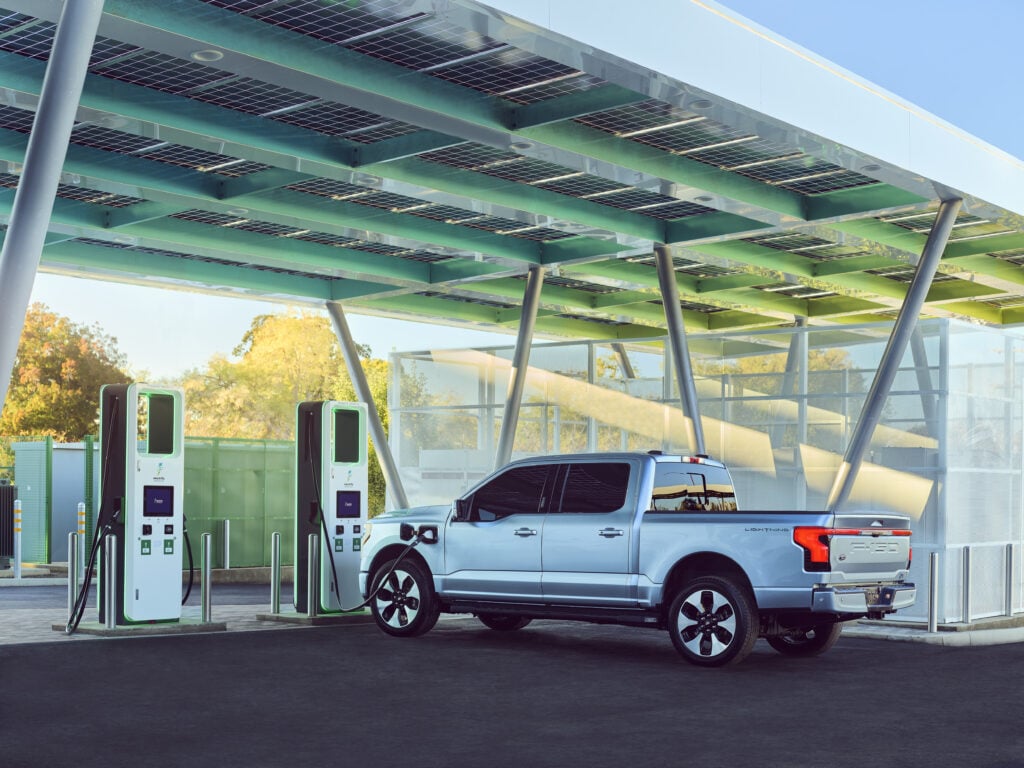
Update: Every day that we wake up to higher gas prices, the case gets stronger for EV adoption. If only EV prices weren’t sky-high. With gas at $4.50, the average American driver commuting 15,000 miles per year can easily save $150 per month or more by going electric. Check out the details below.
Charging an electric vehicle is a whole new experience, one that brings advantages and disadvantages for drivers. If you’ve been stopping at gas stations for decades, the thought of plugging in and waiting for your car to charge may be a bit too much to swallow. But over 80% of EV charging is done at home, where the cost savings are greatest. Two out of three American drivers are considering going electric for their next vehicle, and billions of dollars are being funneled into EV development and infrastructure.
EVs have a higher upfront cost than combustion vehicles, so it’s important to find ways of making up for the expense with fuel savings. Unfortunately, not all charging options are affordable. Here’s how you can save money when charging your EV in 2022.
The Cost of Charging an Electric Car at Home
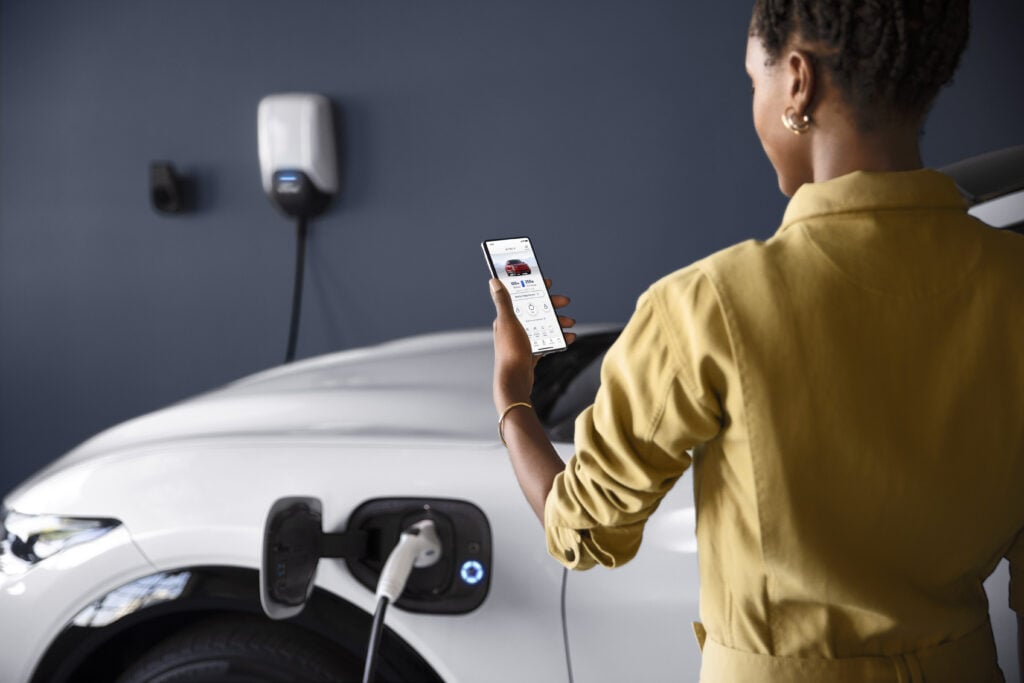
When do you usually charge your phone? While you sleep at home? Oddly enough, for most drivers, that’s exactly how their EVs are charged! Data from the US Department of Energy shows that the vast majority of electric vehicle charging is done at home. Whether you plug in to a simple 120 volt outlet in your driveway or have a more powerful 240 volt outlet in your garage, charging at home is usually the most affordable way to power up.
In the US, the average residential electricity rate is $0.14 per kilowatt-hour, however rates vary widely from one state to another. In Hawaii, the average rate is a whopping $0.34 per kWh, while it’s between $0.10 and $0.14 per kWh in more affordable energy states like Washington and Texas.
What does that all mean? Say you have a level 2 charger capable of filling up your battery from empty in about 7 hours. Plug in every evening, and wake up with a full battery every morning. What did that full ‘tank’ of electrons cost? Let’s consider a real-world example. The 2022 Tesla Model 3 has a 82 kWh battery, so at average American residential rates, at home charging a Tesla Model 3 at home costs just $11.48 for a full charge. That’s enough electrons for 358 miles of driving.
What about if the same Model 3 owner lived in California instead? At typical California residential electricity rates, the same charge would cost $18.04. Considering that a tank of gas costs over $75 today, the savings add up. But clearly, it depends on the rates you pay for power and miles driven per year to maximize savings. If you’d like to know more about average residential electricity rates in each state, you can find that information here.
Here’s How Much a Typical EV Driver Spends on Charging at Home in Every State
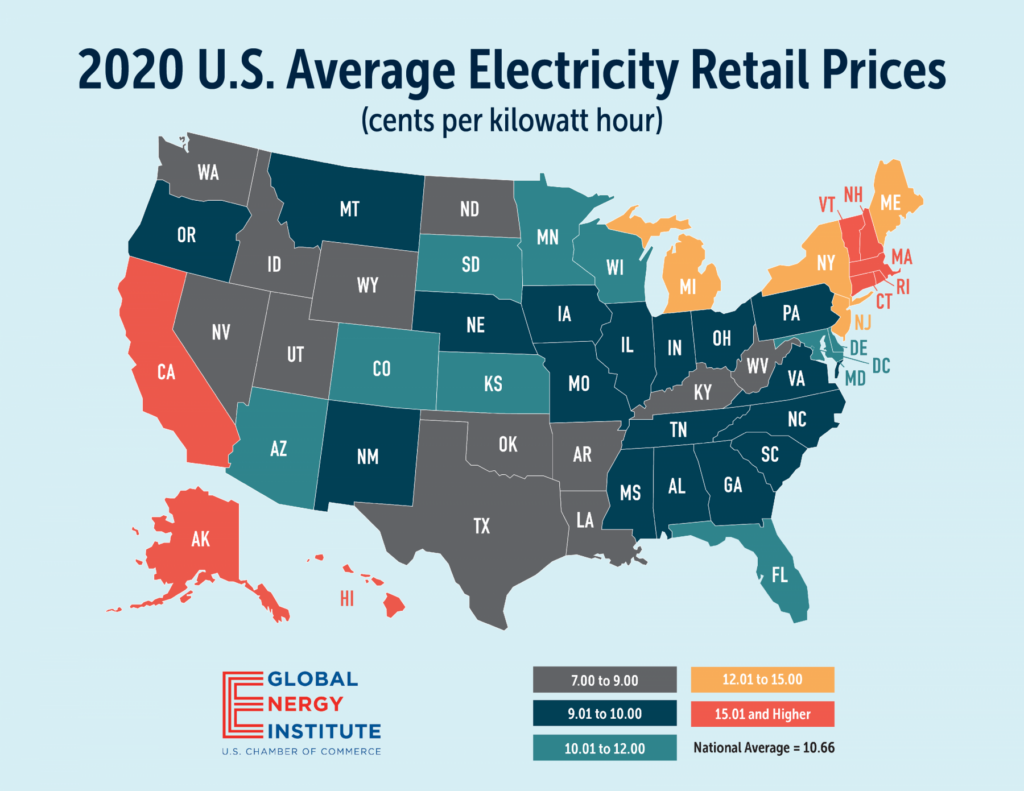
Here’s how much EV drivers from each state can expect to pay for a full charge. The examples below specifically reflect an EV with an 82 kWh battery, such as a Tesla Model 3 or Model Y. My own Hyundai IONIQ 5 has a 72.5 kWh battery.
The stark difference between home charging and public fast charging highlights the fact that going electric likely only brings savings when most charging is done at home.
| State | Residential Electricity Rate ($ per kWh) | Cost of Charging to 100% at Home (82 kWh battery) | EV Fuel Savings Compared to Filling an 18 Gallon Tank at $4.50/Gal | Annual Savings: 15,000 miles/year, 25 MPG versus 300 miles on a charge |
|---|---|---|---|---|
| Alabama | $0.14 | $11.48 | $69.52 | $2,126 |
| Alaska | $0.23 | $18.86 | $62.14 | $1,757 |
| Arizona | $0.13 | $10.66 | $70.34 | $2,167 |
| Arkansas | $0.11 | $9.02 | $71.98 | $2,249 |
| California | $0.22 | $18.04 | $62.96 | $1,798 |
| Colorado | $0.14 | $11.48 | $69.52 | $2,126 |
| Connecticut | $0.23 | $18.86 | $62.14 | $1,757 |
| Delaware | $0.14 | $11.48 | $69.52 | $2,126 |
| DC | $0.14 | $11.48 | $69.52 | $2,126 |
| Florida | $0.12 | $9.84 | $71.16 | $2,208 |
| Georgia | $0.13 | $10.66 | $70.34 | $2,167 |
| Hawaii | $0.34 | $27.88 | $53.12 | $1,306 |
| Idaho | $0.11 | $9.02 | $71.98 | $2,249 |
| Illinois | $0.14 | $11.48 | $69.52 | $2,126 |
| Indiana | $0.14 | $11.48 | $69.52 | $2,126 |
| Iowa | $0.13 | $10.66 | $70.34 | $2,167 |
| Kansas | $0.13 | $10.66 | $70.34 | $2,167 |
| Kentucky | $0.12 | $9.84 | $71.16 | $2,208 |
| Louisiana | $0.12 | $9.84 | $71.16 | $2,208 |
| Maine | $0.18 | $14.76 | $66.24 | $1,962 |
| Maryland | $0.14 | $11.48 | $69.52 | $2,126 |
| Massachusetts | $0.23 | $18.86 | $62.14 | $1,757 |
| Michigan | $0.18 | $14.76 | $66.24 | $1,962 |
| Minnesota | $0.14 | $11.48 | $69.52 | $2,126 |
| Mississippi | $0.12 | $9.84 | $71.16 | $2,208 |
| Missouri | $0.11 | $9.02 | $71.98 | $2,249 |
| Montana | $0.12 | $9.84 | $71.16 | $2,208 |
| Nebraska | $0.11 | $9.02 | $71.98 | $2,249 |
| Nevada | $0.13 | $10.66 | $70.34 | $2,167 |
| New Hampshire | $0.21 | $17.22 | $63.78 | $1,839 |
| New Jersey | $0.16 | $13.12 | $67.88 | $2,044 |
| New Mexico | $0.14 | $11.48 | $69.52 | $2,126 |
| New York | $0.21 | $17.22 | $63.78 | $1,839 |
| North Carolina | $0.12 | $9.84 | $71.16 | $2,208 |
| North Dakota | $0.12 | $9.84 | $71.16 | $2,208 |
| Ohio | $0.13 | $10.66 | $70.34 | $2,167 |
| Oklahoma | $0.13 | $10.66 | $70.34 | $2,167 |
| Oregon | $0.12 | $9.84 | $71.16 | $2,208 |
| Pennsylvania | $0.15 | $12.30 | $68.70 | $2,085 |
| Rhode Island | $0.22 | $18.04 | $62.96 | $1,798 |
| South Carolina | $0.14 | $11.48 | $69.52 | $2,126 |
| South Dakota | $0.13 | $10.66 | $70.34 | $2,167 |
| Tennessee | $0.12 | $9.84 | $71.16 | $2,208 |
| Texas | $0.13 | $10.66 | $70.34 | $2,167 |
| Utah | $0.11 | $9.02 | $71.98 | $2,249 |
| Vermont | $0.21 | $17.22 | $63.78 | $1,839 |
| Virginia | $0.13 | $10.66 | $70.34 | $2,167 |
| Washington | $0.11 | $9.02 | $71.98 | $2,249 |
| West Virginia | $0.14 | $11.48 | $69.52 | $2,126 |
| Wisconsin | $0.15 | $12.30 | $68.70 | $2,085 |
| Wyoming | $0.12 | $9.84 | $71.16 | $2,208 |
The Hidden Costs of Charging an Electric Car
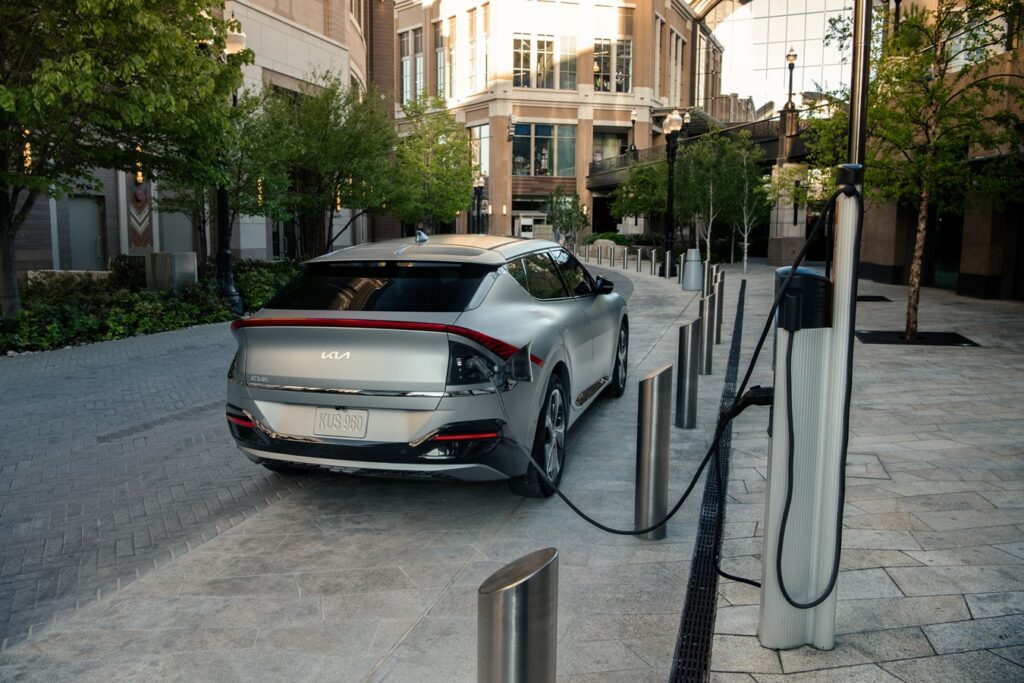
If you already have a 240 volt dryer outlet within reach, you’re all set for just about any scenario. If you don’t, you’re left with two options. If you drive less than 40 miles on most days and live within a reasonable distance of a public charger (in case you need it), you will save the most money by using the so-called ‘trickle charge’ supplied by the charger included with the car. You simply plug into a standard three-prong 120 volt wall outlet. This is called level 1 charging.
Depending on the vehicle, trickle charging typically adds 3-4 miles of charge per hour to the battery, or about 40 miles per night if you leave your car plugged in. So, how much does it cost to charge an electric car? If the above scenario describes your driving habits, you’ll just pay the same residential electricity rates that your pay to power your home.
If that’s not quite enough recharge for your daily needs, you’ll either need to make weekly visits to public fast chargers, or spend anywhere from $800 – $2000 on installation of a level 2 charger. Level 2 chargers supply more power in less time. They plug into a 240 volt outlet, the exact same kind that is used for dryers, ovens and other large appliances at home.
If you already have a conveniently located dryer outlet within reach of where you park the car, you can purchase a power splitter for as little as $300. Splitters send charge to the home appliance (such as a dryer) when needed, and then divert power to charging the car when the appliance is not in use. This saves A LOT of money versus getting electrical work done!
Do I need to install a charger?
In summary, if you drive less than 40 miles a day, it usually makes the most sense to avoid the costly level 2 charger and stick with a regular wall outlet. If you drive significantly more, consider installing a level 2 charger or simply topping off your battery once or twice a week at a local public fast charger to avoid the expense of electrical work.
How Much Does Public Fast Charging Cost?
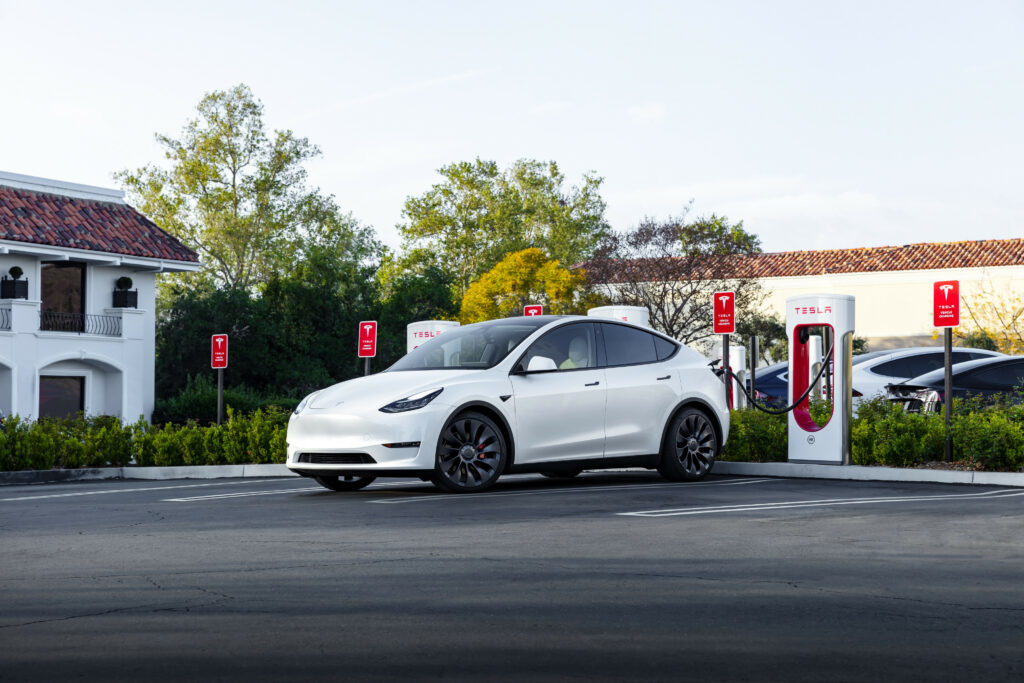
First, there’s one thing we need to make clear. Electric vehicles are not meant to be charged at public DC (direct current) fast chargers every time a charge is needed. It stresses the battery, and it costs a lot more than charging at home. For instance, fast chargers can charge a Model 3 from 10-80% in less than 20 minutes. That much energy transfer puts wear on the vehicle’s battery management system. Fast charging is great for road trips or when you’re in a pinch, but that’s all they’re meant for.
Get the most when you sell your car.
Compare and choose multiple offers in minutes:
Tesla Superchargers
How much can you expect to pay for charging at a public DC fast charging station? Let’s consider the two largest charging networks in the nation: Tesla Superchargers and Electrify America.
As of early 2022, most Tesla Superchargers charge $0.28 per kWh of electricity. For a 2022 Tesla Model Y with a 82 kWh battery pack, that adds up to a cost of $22.96 to go 330 miles on a charge. Some Superchargers have variable pricing dependent on demand charges, as noted on Tesla’s Supercharging support page. “Certain Supercharger stations offer on-peak and off-peak rates. The rates and peak times are both displayed in the navigation application on the touchscreen.”
Depending on state and local regulations, some Tesla Superchargers charge per minute, rather than per kilowatt-hour of electricity. Tesla recently updated the rate structure for their per-minute Superchargers. With Tesla’s plug-and-charge, customers simply plug in the vehicle and the charger communicates with the car, begins charging and bills the customer’s Tesla account.
Here’s how the updated rate structure is tiered in 2022:
Source: Tesla
Electrify America
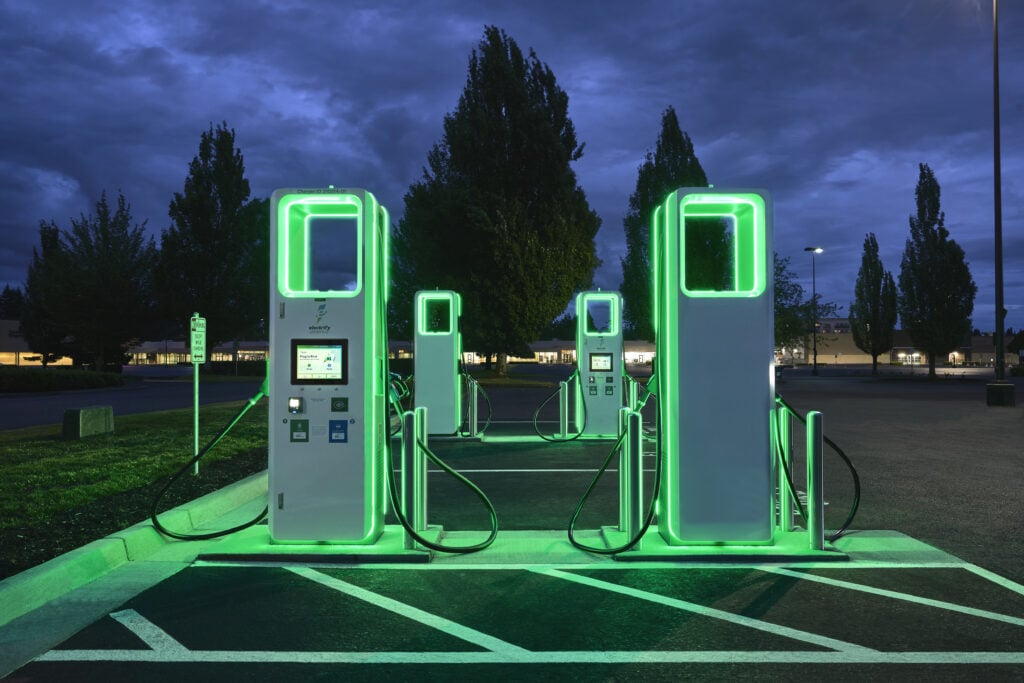
Over at Electrify America, customers can either pay $0.43 per kWh of electricity, or become a Pass+ member for just $4/month and charge at $0.31 per kWh. Having such an affordable membership plan is an interesting approach. That is to say, it almost seems like Electrify America is aiming to become a subscription that everyone with an EV will buy into for a sense of range security, even if they rarely use the network. Down the road, I’m sure prices will go up.
For a Ford Mustang Mach-E, filling up the 98 kWh battery from empty will cost $30.38 with the Pass+ membership. However, the cost jumps to $42.14 without it. Clearly, the fuel savings we often associate with going electric evaporate if charging costs are too high.
| Cost of Charging to 100% at a Tesla Supercharger | Cost of Charging to 100% at Electrify America as a Member | Cost of Charging to 100% at Electrify America as a Guest | Cost of Filling up an 18 Gallon Tank of Gas at $3.25/Gallon |
| $22.96 | $25.42 | $35.26 | $58.50 |
Some Drivers Don’t Spend a Dime on Charging
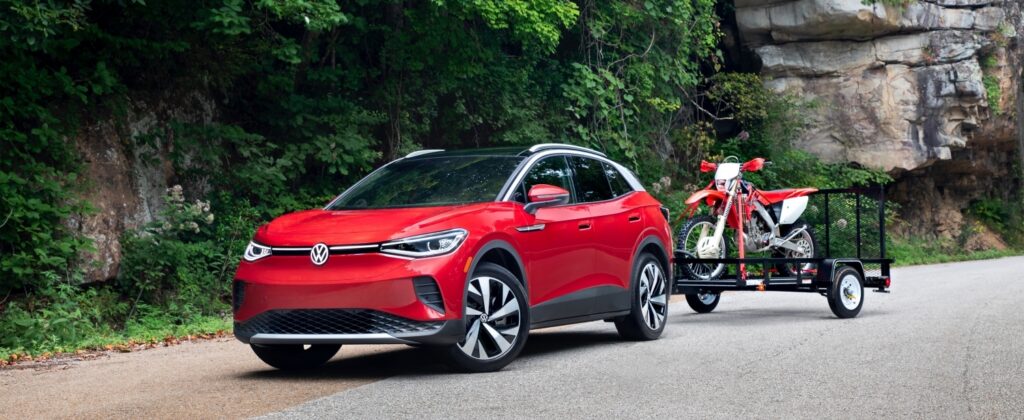
If you know someone who pulls up to Tesla Superchargers in their 2014 Model S and leaves without paying a dime, don’t expect the same perks when shopping for a 2022 Tesla. Early adopters received free supercharging ‘for life’, and there are plenty of Tesla owners out there who keep driving their high-mileage, slow-charging old Model S just for the free charging incentive.
If you’re hoping to score free charging with any of the 2022 EV models, I’ve got good news for you. Many 2022 models come with free charging at Electrify America charging stations. These new EVs all come with a free charging incentive for a limited time:
- Audi e-tron (250kWh at Electrify America, or about 1,000 miles of driving)
- Audi Q4 e-tron (250kWh at Electrify America, or about 1,000 miles of driving)
- Ford Mustang Mach-E (250kWh at Electrify America, or about 1,000 miles of driving)
- Hyundai IONIQ EV (250kWh at Electrify America, or about 1,000 miles of driving)
- Hyundai IONIQ 5 (2 years of free charging at Electrify America, 30 minutes per session)
- Hyundai Kona EV (250kWh at Electrify America, or about 1,000 miles of driving)
- Lucid Air (3 years of free charging at Electrify America)
- Mercedes EQS (2 years of free charging at Electrify America, 30 minutes per session)
- Polestar 2 (2 years of free charging at Electrify America, 30 minutes per session)
- Porsche Taycan (3 years of free charging at Electrify America, 30 minutes per session)
- Rivian R1T and R1S (12 months of free charging at Rivian’s Adventure Network and Waypoint chargers; continued free charging with Rivian membership subscription)
- Volkswagen ID.4 (3 years of free charging at Electrify America, 30 minutes per session)
Some employers, especially large corporations and tech companies, offer free charging for EVs at dedicated parking spots. However, if your employer doesn’t offer charging, maybe you can be the one to spark the idea and help make it happen.
Ever thought of installing solar panels on your roof?
Prices have plummeted in recent years, and having an EV is yet another incentive to go solar. Most utility customers can participate in a net metering program that compensates homeowners for unused solar electricity contributed to the grid. If the sun is shining bright while you’re away at work, you still receive bill credits for the unused power your panels generated. The utility bill credits you’ll receive may cover the entire cost of charging your car. That’s 100% clean, free power for both your home and transportation!
CarEdge’s Take on the Future of EV Charging
How much does it cost to charge an electric car? As you can see, it depends on utility rates, incentives and if you charge at home or at public fast chargers. Fuel savings is one of the greatest benefits of switching from a combustion vehicle to an electric vehicle. As your consumer advocate, we want to make it clear that EVs don’t always save money. However, for the vast majority of American drivers, affordable electricity rates mean that at least $1,000 could be saved each year by going electric. And that doesn’t include the lower maintenance costs that most EVs have. For those who are fortunate to have a place to plug in at home or work, switching to an electric vehicle is a no-brainer.
Have any questions or comments? How are you feeling about the electrification of the auto industry? Let us know in the comments below, or check out the CarEdge Community forum at caredge.kinsta.cloud. You can also reach out to me at [email protected].










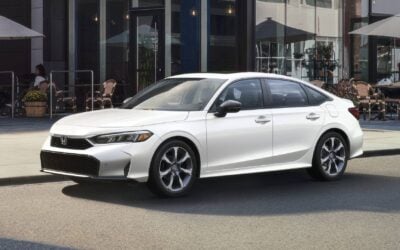


If I’m not mistaken, at least here in NY, the price you pay per kWh depends on the time of day. Here (in upstate NY), prices go down between 9pm and 6am (maybe 7am, I forget). So it definitely makes financial sense to charge your vehicle at night, starting after 9pm, rather than during the day.
That’s true! I live one mile from the Virginia border. Where I live, there are no savings for charging at night. Down the street in Virginia there are. I believe over 50% of the nation has cheaper electricity at night.
One option many people don’t know about is time-of-use plans offered by electric companies. These plans offer tiered pricing based on when you use electricity with late night hours being especially cheap. These plans are ideal for EV owners that charge their vehicles overnight. My power company charges me $0.014/kWh for electricity between 11PM and 7AM and that’s when I charge. I can literally charge for pennies a day. I’ve put about 14,500 miles on my car in the last year and it has cost me less than $90 in electricity. I was spending $120-$150 per MONTH on gas pre-pandemic driving a mid-size ICE sedan.
There is really only a single peak period in my plan and that is between 2PM and 7PM from June 1-Sept 31, the rest of the time is off-peak or super off-peak. My overall power bills have also decreased since moving to a TOU plan despite actually using slightly more electricity.
We have been driving electric for 3 years. My wife works an hour away from home – every other day she takes the leaf or the Prius. I walk to work. As we live in an apartment, we can charge on site either through the level 2 public charging stations on site or level 1 at our parking spot. We frequently use dc fast charging. Even so, the battery holds up very well and throttles charging if the temperature goes up. The other thing is the car is also less expensive to maintain. That’s easy to forget! (We were a one car family for awhile – boy did that save money!!!). Maintenance is a bunch of little things that add up. Even if we spend a lot on electricity it is about half the expense of gassing up our Prius. I just got new tires on the leaf.
Great point! Here at CarEdge, we plan to dig into the details of EV maintenance costs and savings. I appreciate your insights! With your electric experience, what are some topics that you feel deserve more unbiased coverage in the media?
I think its to early to tell if going electric will be the cost saving it is being lead to believe and the distance you can travel per charge is still not long enough for some to make the move. Also the power grid is not robust enough either to handle the so called large number of people that will change to electric and solar and wind are limited at best. I can see electrics being more of an urban vehicle while fossil fuel vehicles will still be the choice for long distance travel. people also have to look at the other side of the electric coin so to speak when it comes to replacing the batteries. They are not recyclable and the cost are in the thousands of dollars making owning an electric for most families unrealistic. Hydrogen fuel cells, maybe a better option in the future?
Thanks for sharing your thoughts. One of the exciting things about the auto industry today is all of the unknowns. Everything will be quite different a decade from now. From what I’ve researched, as of now hydrogen fuel cells have the greatest potential for long-haul transportation, such as trucking. Even though we’re surrounded by hydrogen in water and the atmosphere, it’s not easy to extract it and make it usable for fuel. It’s possible, but energy-intensive. The hydrogen powered Toyota Mirai has not really caught on so far.
Who wrote this mess! That has to be one of the best pieces that I’ve read in awhile. I had many questions that were answered. I have twin daughters in college and they have no home chargers and who know at college. I would hate from them to use fast chargers all the time. And who needs a car in DC it’s a liability. Electric rates cary, get in my county in Florida we have a Coop and rates are great and the same throughout the day.
People get hyped up with EV’s you wait brothers! Our infrastructure sucks. If by magic we all had EV’ s overnight we would literally melt all the lines if everyone had to charge. Not only that look at all the gasoline taxes we pay, believe me down the road they will tax EV’ s more or the electric for EV’s.
Look at California and the knucklehead bill they are trying to push. Since the federal gov’t is giving tax credits for solar the genius idea is that Cali want to tax solar or raise rates to that that credit away from the buyer. It will dramatically raise the cost of solar to the point most will not bother.
Hi Brian! I wrote it, and I appreciate your feedback. We’re trying our best to provide consumers with truly useful information and perspectives for the rapidly changing automotive industry. Consumers need a voice with so much in transition, and prices all over the place. I hope you’ll join the discussions at wordpress.caredge.kinsta.cloud!